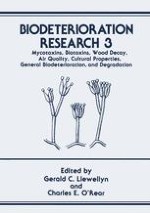1990 | OriginalPaper | Buchkapitel
Deterioration of Air Quality in Firing Ranges: A Review of Airborne Lead Exposures
verfasst von : Ram K. Tripathi, Gerald C. Llewellyn
Erschienen in: Biodeterioration Research
Verlag: Springer US
Enthalten in: Professional Book Archive
Aktivieren Sie unsere intelligente Suche, um passende Fachinhalte oder Patente zu finden.
Wählen Sie Textabschnitte aus um mit Künstlicher Intelligenz passenden Patente zu finden. powered by
Markieren Sie Textabschnitte, um KI-gestützt weitere passende Inhalte zu finden. powered by
Exposure to airborne lead in indoor (Fischbein et al., 1979; Novotny et al., 1987; Landrigan et al., 1975; Smith, 1976; NIOSH, 1975; Anderson et al., 1977; Olmez et al., 1984;) and outdoor firing ranges (Tripathi et al., 1989a, b) is a documented occupational health hazard. Deterioration of air quality in firing ranges poses a serious health threat to personnel who work in shooting ranges, both commercial and private. Airborne lead, dust, and fumes generated by the firing guns, cause an accumulation of lead in the blood of firearm instructors, maintenance workers, and shooters. A study conducted by the National Institute for Occupational Safety and Health (Anania and Seta, 1975) reported an average airborne lead concentration from nine indoor firing ranges of 2,700 μg/m3, almost 54 times the current Occupational Safety and Health Administration (OSHA) standard of 50 μg/m3 (OSHA, 1978). Another recent study conducted by Tripathi et al., (1989a) from an outdoor firing range reported an average airborne lead concentration of 129 μg/m3.
